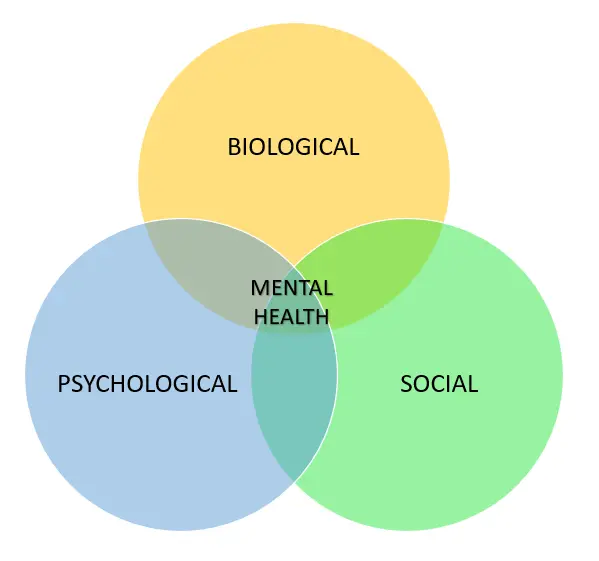Mental illness affects so many people in a vast array of ways. But one of the most frustrating aspects of mental health is that we don’t truly know what causes mental illness.
One of the most commonly accepted approaches towards mental health is the suggestion that a range of different, interrelated factors, contribute towards the onset of a mental health condition.
The factors involved can be deemed as biological, psychological or social. The theory that introduces this concept is known as the Biopsychosocial model. In this article, we review this potential cause of mental illness.

The Model
The model, as shown below, involves three key areas – biology, psychology and social. These three areas combine to form a triumvirate that some believe can explain the cause of mental health conditions.

The model actually dates back to researchers George L. Engel and Jon Romano, who first published his research in 1977 [1]. It has since become used as one of the most common explanations of how mental health conditions develop.
The model suggests that elements from each of the three factors will combine as part of what triggers a mental health condition developing. The authors suggested these factors all interact, and could be applied to both physical and psychological illnesses.
We now take a look at the three different main factors used within this model, and the specific areas within each main area.
Biological Factors
Biological factors focus mainly on genetics. For instance, mental health conditions often run throughout generations of families, which can make some people more vulnerable to developing mental illness.
Physical health also plays an important role here. Some physical ailments, such as those that leaves someone terminally ill or bed-bound, can leave someone more susceptible to mental illness.
Psychological Factors
Psychological factors encompass a wide range of areas. The attitude of a person, such as whether or not they are seen as a positive or negative person, their self-esteem, coping skills and their general beliefs all fall under this branch.
Other areas such as how resilient a person is, their IQ level, past traumas and early childhood experiences are all examples of other elements within this overall branch.
Social Factors
Social factors account for a wide variety of areas. A person’s friends and family are very important here. If someone doesn’t get on well with their family, or struggles to make friends, this can be difficult to live with. Everyone needs a support network.
Not enjoying school or work, or being around toxic individuals can also be a contributory factor. The culture that some people live in can be yet another factor.
Upbringing, encountering trauma and as touched on earlier, a person’s support network are all examples of social factors that are elements of consideration.

What is an example of the Biopsychological Model?
An example of this approach would be if an individual had a parent who had suffered from mental illness, then they may have a genetic predisposition for mental illness. But this alone wouldn’t trigger a condition. But if they have social problems e.g. loneliness, this could trigger a condition developing.
Is the Biopsychological model accurate?
Engel and Romano’s ideas at the time were seen as rather groundbreaking, with their theory marking a departure from the biomedical approach that was favoured at the time.
There is certainly evidence to support this theory and it is one endorsed by the World Health Organisation. Many who suffer from mental health conditions could point to certain areas within these factors as being potential contributory parts to their illness.
There has been no shortage of criticism of this idea. Some suggest that the idea is not specific enough, with the approach adopting somewhat of an “all and sundry” approach where everything is considered. There is also the idea that there is too much overlap between the three factors [2].
What is the biomedical approach?
As mentioned briefly above, the biomedical approach for many years was seen as the most accurate approach to determining the cause of mental health conditions.
The biomedical approach follows the idea that mental illness is caused by a brain abnormality and therefore treats mental health conditions like a physical health condition.
The biomedical theory suggests that abnormalities in the brain take the form of chemical imbalances. These chemicals are called neurotransmitters, with the belief that medication like antidepressants can regulate the balance.
While the biomedical theory does still retain the support of many, there is now also a lot of backing for the psychosocial approach. Ultimately, it is the treatment and associated recovery that matters the most.
Summary
We will never truly know the exact causes behind mental illness. But the biopsychosocial approach certainly makes sense, and at the very least, provides a foundation to base our ideas on.
The model suggests that healthcare professions should consider a wide breadth of possible factors that could have caused mental illness. This can enable a person to identify any harmful experiences or traits in their personality that could be affecting them.
Disclaimer
This website should be used purely for informational purposes, and does not intend to, nor should it ever, be used as a replacement for professional medical advice.
We strive to keep all of our pages updated, and ensure that our website is full of factual and in-depth information. However, we encourage you to browse this website with care.
As a reminder, this website and all content within it cannot and should not replace the advice of a trained medical professional. You can read our full disclaimer at this link.
Helplines
If you are struggling with your mental health, help is available. With the right support and treatment, you can make a recovery. For information on helplines, or if you are in a state of crisis, please visit our crisis page by clicking on the relevant link for your geographical location (United Kingdom), (United States), (International). You can also see how to get mental health treatment and the process involved by clicking this link.
References
[1] Engel, G. L., & Romano, J, (1997). The need for a new medical model: a challenge for biomedicine. Science. 196(1). p129-136.
[2] Gaemi, S. N. (2011). The Biopsychosocial Model in Psychiatry: A Critique. An International Journal in Philosophy, Religion, Politics, and the Arts. 6(1). p1-8.





























